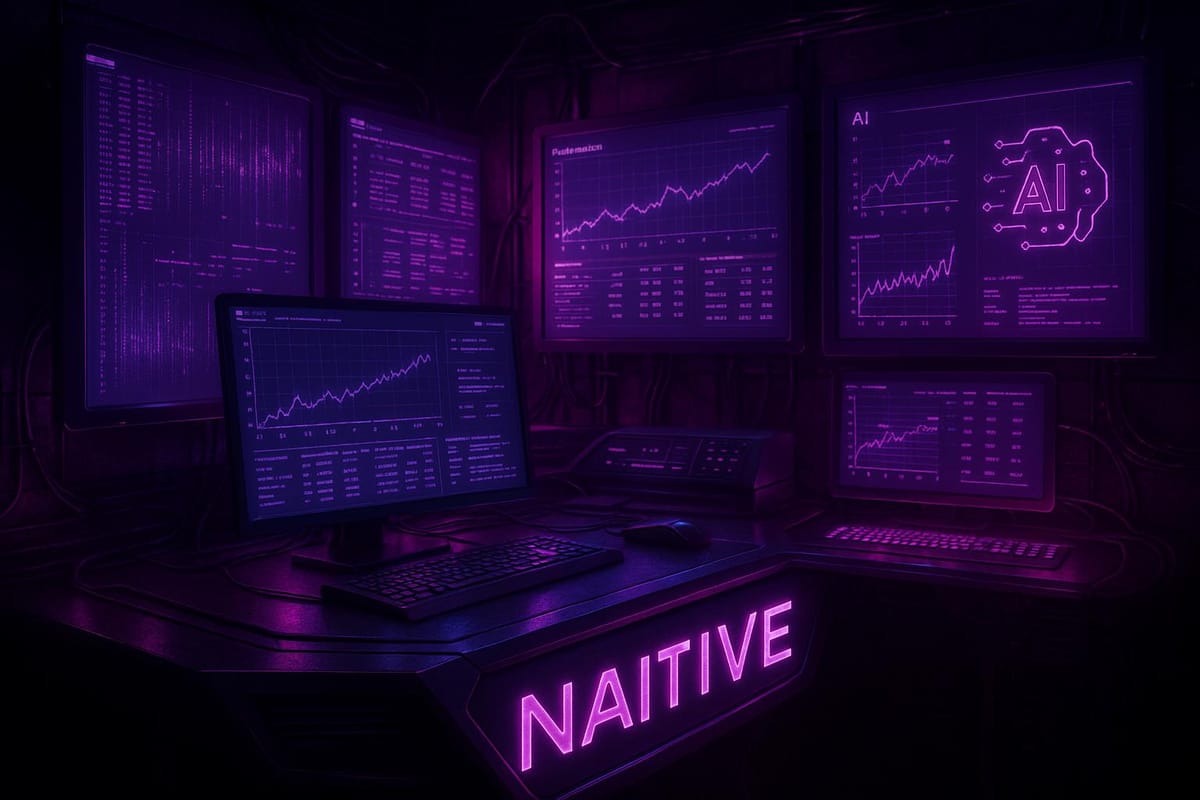How to Monitor AI Models for Early Degradation
Learn how to effectively monitor AI models to prevent performance degradation and maintain accuracy, reliability, and compliance over time.

AI models lose performance over time, impacting accuracy, speed, and reliability. This happens due to changing data patterns, user behavior shifts, or technical issues. Studies show 60% of AI models experience performance drops within their first year. Without proper monitoring, these declines can lead to financial losses, compliance risks, and customer dissatisfaction.
Key Takeaways:
- Track metrics like accuracy, latency, and data drift to detect issues early.
- Use tools like OpenTelemetry, Grafana, and SageMaker Model Monitor for real-time monitoring.
- Set dynamic thresholds based on historical data to spot anomalies.
- Combine real-time alerts with historical trend analysis for a complete view.
- Ensure compliance by encrypting data, restricting access, and maintaining detailed logs.
Monitoring AI systems is essential to prevent costly failures and maintain trust. Investing in continuous oversight not only safeguards performance but also supports better decision-making and system reliability.
Model Monitoring: What, Why, and How
Key Metrics and Threshold Setting
Tracking the right metrics is like having a compass for your AI system - it ensures you're heading in the right direction and alerts you when things go off course. Without proper monitoring, you might not notice performance slipping until it's too late. The trick lies in identifying the most important metrics and setting thresholds that detect problems early enough to avoid serious consequences. Let’s dive into the key metrics and how to set thresholds that work for your needs.
Core Metrics to Monitor
When it comes to AI models, understanding performance is non-negotiable. For classification models, focus on metrics like accuracy, precision, recall, and F1 score to measure how well predictions align with reality. For regression models, keep an eye on mean absolute error (MAE) and mean squared error (MSE) to assess how far predictions deviate from actual values. Other metrics, such as ROC-AUC and log loss, can provide deeper insight into your model's confidence levels.
Operational metrics are just as important. Inference latency measures how quickly your model delivers predictions, which is crucial for maintaining a smooth user experience. Throughput tells you how many predictions your system can handle in a given time, reflecting the efficiency of your infrastructure. Additionally, monitoring resource usage, like memory and CPU utilization, can alert you to potential bottlenecks or inefficiencies.
Data quality metrics serve as an early warning system. Keep tabs on missing values, outliers, and schema changes in your input data. Poor data quality often leads to degraded performance, so catching these issues early can save you from larger problems down the line.
Business KPIs bridge the gap between technical metrics and real-world outcomes. For instance, a recommendation system might track click-through rates and user engagement, while a fraud detection model should monitor false positive rates to ensure customer satisfaction. These metrics help you see the ripple effects of technical issues on your bottom line.
Drift detection metrics are another critical component. Over time, your input data may shift in ways that challenge your model’s accuracy. Using statistical measures like the Population Stability Index (PSI), KL Divergence, or Wasserstein Distance, you can spot these subtle changes before they cause major disruptions.
| Metric Type | Example Metrics | Purpose/Insight |
|---|---|---|
| Model Performance | Accuracy, F1 score, MAE, MSE | Tracks prediction quality |
| Data Quality | Missing values, outliers | Ensures the integrity of input data |
| Drift Detection | PSI, KL Divergence | Detects shifts in data or model behavior |
| Operational | Inference latency, throughput | Monitors system efficiency and response times |
| Business KPIs | Conversion rate, revenue | Links technical performance to business outcomes |
Setting Dynamic Thresholds
Static thresholds might seem straightforward, but they often fail to account for the complexities of real-world AI systems. Factors like seasonality, user behavior, and business cycles can cause performance to fluctuate. That’s where dynamic thresholds come in - they adapt to these patterns, using historical data to define what’s normal and flag anomalies early.
Start by establishing baselines during your model’s initial deployment. Gather performance data over a period of about 30 days to understand what normal variation looks like. From there, calculate standard deviations from the mean to define acceptable ranges. For example, values that fall outside two standard deviations might signal potential issues.
Here are some practical examples of thresholds to consider:
- Accuracy dropping below 90%.
- Latency exceeding 500 milliseconds.
- Throughput falling below 1,000 predictions per minute.
- A 5% drop in conversion rates.
According to a Forrester study, organizations that implemented comprehensive AI observability, including dynamic thresholds, saw an 80% reduction in AI downtime and a 90% improvement in addressing data quality issues.
Regular reviews of your thresholds are just as important as setting them. Schedule monthly or quarterly evaluations to ensure your thresholds remain relevant. If you make significant changes - like retraining your model, encountering shifts in data distribution, or adjusting business processes - revisit your thresholds immediately. Automated monitoring tools can also help by flagging frequent threshold breaches, prompting timely updates.
For even greater precision, consider using automated anomaly detection. Machine learning algorithms can identify complex patterns and subtle deviations that static thresholds might miss, reducing the need for constant manual adjustments.
The challenge lies in finding the right balance. Set thresholds too tightly, and you’ll be overwhelmed by false alarms. Set them too loosely, and you risk missing critical issues until it’s too late. A good starting point is to set conservative thresholds and adjust based on your team’s ability to investigate and respond effectively.
Finally, don’t go it alone. Involve data scientists, engineers, and business stakeholders in the process. Their input ensures that your monitoring system aligns with both technical requirements and business goals. With well-tuned thresholds in place, you’ll be ready to catch problems early and keep your AI system running smoothly.
Setting Up Monitoring Systems
Once you've identified your key metrics and set thresholds, the next step is creating a monitoring system that keeps a constant eye on these indicators and reacts to any changes. A well-integrated monitoring setup can flag potential issues before they spiral out of control.
Continuous Monitoring Setup
To implement continuous monitoring, start by equipping your models to gather essential data. OpenTelemetry has become a widely-used framework for this, offering a unified approach to collecting metrics, logs, and traces from AI applications. It’s versatile and works across platforms, making it a reliable choice for data collection.
The setup process involves integrating OpenTelemetry SDKs into your application code and configuring exporters to send the collected data to a monitoring platform of your choice. For visualization and alerting, Grafana is a standout tool. It connects seamlessly to data sources like Prometheus and InfluxDB, enabling you to build real-time dashboards that provide a clear picture of your model's performance.
If you’re looking for automated solutions, Amazon SageMaker Model Monitor is a great option. It compares live data to your training baselines and can automatically trigger alerts or even retraining when needed, saving you the effort of setting up these processes manually.
Another robust tool is Datadog, which offers comprehensive monitoring that correlates AI metrics with overall system health. This can help pinpoint the root causes of issues more effectively.
To ensure smooth data flow, set up automated pipelines that stream key outputs - like predictions, input features, confidence scores, and response times - directly to your monitoring tools. Without this continuous data stream, critical issues might go undetected.
Once the data is flowing, the next priority is configuring real-time alerts and logging to catch problems as they arise.
Real-Time Alerts and Logging
Effective alerting goes beyond just setting thresholds. Your system needs to differentiate between genuine issues and normal fluctuations. For example, configure alerts for critical metrics like accuracy dropping below 90%, latency exceeding 500 milliseconds, or sudden spikes in error rates. The goal is to catch these problems within minutes, not hours.
Structured logging is key to troubleshooting effectively. Every interaction with your model should generate a log entry that includes details like input features, predictions, confidence scores, timestamps, and metadata (e.g., user or session IDs). This level of detail allows you to trace issues back to their origins and even replay specific interactions to diagnose problems.
To manage logs efficiently, use centralized storage solutions like Elasticsearch or cloud-based platforms. These systems ensure your logs remain accessible and searchable, even as the volume grows. You might also consider log sampling or retention policies to balance costs with the need for detailed data.
One common challenge is alert fatigue - when too many false positives overwhelm your team. Start with conservative thresholds and adjust them over time based on your team’s capacity to investigate. Make sure alerts are routed to the right people by integrating with tools like Slack or Microsoft Teams.
For high-stakes applications, consider adding escalation procedures. If an alert isn’t acknowledged within a set timeframe, senior team members can be automatically notified. This ensures critical issues don’t fall through the cracks during busy periods or shift changes.
While real-time alerts are crucial for immediate response, historical monitoring helps uncover slower, long-term trends.
Real-Time and Historical Monitoring
Combining real-time and historical monitoring offers a complete view of your model's health. Real-time monitoring acts as your first line of defense, catching sudden issues like server outages, memory leaks, or sharp drops in accuracy. These problems often require immediate attention to avoid extended downtime or a poor user experience.
Historical monitoring, on the other hand, helps identify gradual changes that happen over weeks or months. For instance, as user behavior evolves or data patterns shift, a model’s accuracy may slowly decline. Such performance drift might not trigger real-time alerts but can still have a significant impact on your outcomes over time. In fact, a study by Acceldata found that over 60% of organizations cite model drift and data quality issues as the leading causes of AI model failures in production.
Research involving 20,000 simulated model deployments revealed a consistent pattern: as models age, their error rates tend to increase. This highlights the importance of monitoring both immediate incidents and long-term trends.
To track historical performance, maintain baselines from your model's initial deployment and compare current metrics against them regularly. Tools like Evidently AI are particularly useful for this, offering detailed drift detection and trend analysis to help you understand your model's evolution.
Automated reporting can also be valuable. Weekly or monthly summaries that highlight trends, improvements, and stable periods can reassure stakeholders about the reliability of your AI systems.
The combination of real-time and historical monitoring not only improves issue detection but also informs smarter decisions about model updates and retraining. Instead of relying on fixed schedules, you can base these actions on actual performance data, ensuring resources are used more effectively.
Start with the basics - key metrics and alerts - and expand your monitoring setup as your needs grow.
Early Warning Signs Detection
Modern monitoring systems do more than just track basic metrics - they’re designed to pick up on subtle patterns that could indicate potential problems before they snowball. Once continuous monitoring and threshold alerts are in place, early warning detection takes things a step further by identifying anomalies and shifts that might otherwise go unnoticed. These advanced techniques allow teams to address issues proactively, keeping systems running smoothly.
Anomaly Detection Methods
Statistical tools and machine learning methods are at the heart of anomaly detection. Take z-score analysis, for instance - it calculates how far a data point deviates from the mean. If your model’s performance metrics stray significantly from historical averages, it might be a red flag.
Control charts are another effective tool. By plotting key metrics over time and marking limits for acceptable performance, they can quickly highlight when something’s off. For example, if a model’s error rate suddenly spikes beyond its normal range, a control chart will make that clear.
Machine learning methods, like autoencoders and isolation forests, add another layer of sophistication. These techniques learn what "normal" looks like and flag deviations. Isolation forests, for example, excel at identifying outliers in patterns like resource consumption, which could signal potential model failures.
What makes these automated methods so valuable is their ability to run continuously. They can alert your team the moment anomalies appear, enabling quick action. Beyond anomaly detection, monitoring for drift provides deeper insights into how data patterns evolve.
Model Drift Monitoring
In rapidly changing production environments, data doesn’t stay static - it evolves. Monitoring systems need to catch these shifts early to prevent performance issues. Data drift happens when the statistical properties of input features change over time, while concept drift occurs when the relationship between inputs and outputs shifts.
Drift metrics are essential for spotting these changes. They help identify both obvious shifts and more subtle trends that could impact model behavior.
Another useful signal is monitoring prediction confidence scores. Research has shown that as models age, metrics like mean squared error tend to increase, highlighting performance degradation over time. These quantitative measures, combined with automated tools, create a robust system for continuous validation.
Feedback Loop Integration
Automated systems are powerful, but they’re not perfect. That’s where user feedback comes in. Real-world users often interact with models in ways that testing environments can’t fully replicate, making their input a critical piece of the puzzle.
For instance, user reporting systems should make it easy to flag unexpected or incorrect predictions. Apple’s experience with its AI-powered news summary tool is a good example. Early user reports of false notifications allowed Apple to quickly disable the feature and issue updates, avoiding widespread misinformation.
Structured feedback sessions with business users, product managers, and domain experts can also uncover issues that purely technical metrics might miss. By integrating this feedback into continuous validation workflows, teams can monitor not just the technical performance of a model but also its practical, real-world impact.
This human-in-the-loop approach strengthens early detection by combining automated insights with real-world context. For organizations aiming to implement these techniques, tailored solutions - like those offered by NAITIVE AI Consulting Agency - can help design and manage robust monitoring systems to catch early signs of performance issues.
Governance and Incident Response
When continuous monitoring picks up on early performance issues, having strong governance and incident response protocols becomes essential. These protocols not only help maintain trust but also ensure compliance with regulatory requirements and protect business continuity. Organizations must strike a balance between technical response capabilities, compliance needs, and operational stability.
Compliance and Accountability
In the U.S., privacy controls and audit trails are non-negotiable. For healthcare organizations, this means strict adherence to HIPAA when monitoring AI models that handle patient data. Similarly, financial institutions and consumer-facing applications must comply with standards like the CCPA for California residents.
To meet these requirements, organizations need to implement robust privacy controls. This includes:
- Anonymizing or pseudonymizing user data in logs.
- Encrypting monitoring data both at rest and in transit.
- Restricting access to dashboards, ensuring only authorized personnel can view sensitive information.
Automated alerts should flag unauthorized access attempts, and regular audits of data handling processes help ensure these safeguards remain effective. Additionally, organizations must document system changes and model decisions with secure, timestamped logs. This includes keeping records of model inputs and outputs, tracking data access, and logging any adjustments to monitoring systems or thresholds.
Limiting access to sensitive data is another key step in reinforcing accountability. Role-based permissions ensure that only designated team members can access production monitoring dashboards, and an even smaller group should have the authority to modify system configurations. This approach minimizes the risk of unauthorized changes that could mask performance issues.
Automated monitoring tools can simplify compliance efforts by generating standardized incident reports and maintaining historical records. These tools make audits smoother while ensuring consistent documentation practices.
With these compliance measures in place, the next step is to establish a swift and effective incident response process.
Incident Response Process
Anomalies need to be detected and escalated immediately, following predefined procedures that specify who gets notified for different types of issues. For example, a financial institution might configure alerts to notify the risk management team if a credit scoring model's accuracy drops below a certain threshold. Persistent issues could then be escalated to executive leadership.
Teams must perform root cause analysis right away, using logs and traces to determine whether the issue stems from data drift, infrastructure problems, or changes in the business environment. Findings should be documented for future reference.
Addressing the issue might involve temporarily rolling back to a previous model version while developing a long-term solution. Automated rollback capabilities can minimize downtime, but clear protocols for manual intervention should also be established.
Every incident should conclude with thorough documentation and review. Reports should capture the timeline of events, affected systems, root causes, and corrective actions taken. Post-incident reviews are invaluable for refining monitoring strategies and strengthening preventive measures.
For instance, SageMaker Model Monitor once detected a drop in fraud detection precision, prompting a rapid investigation and resolution within 24 hours.
Risk Management Integration
Beyond addressing immediate issues, monitoring insights should feed into enterprise risk management to anticipate future problems. By incorporating monitoring data into risk dashboards, organizations can quantify model health in real time and evaluate potential business impacts.
These dashboards should combine model performance metrics with other business indicators, such as financial performance and customer satisfaction. This allows organizations to see how AI system health ties into broader business outcomes.
Proactive risk management also involves analyzing historical data to estimate financial losses, assess reputational risks, and flag potential compliance concerns. For example, organizations can identify seasonal variations in model performance, evaluate how data changes affect models, and plan retraining schedules to address degradation before it impacts operations.
Integrating monitoring data into risk management enables teams to predict when models might need attention and schedule maintenance during less critical periods, preventing small issues from escalating into major problems.
For organizations looking to build or refine their governance and incident response frameworks, external expertise can be a valuable resource. NAITIVE AI Consulting Agency provides services that emphasize "compliant deployment" of AI solutions. Their managed service approach covers updates, fine-tuning, and performance monitoring, allowing internal teams to focus on business goals while maintaining strong oversight of AI systems.
This holistic approach ensures that monitoring capabilities align with business objectives while meeting the accountability and compliance standards necessary for modern AI deployments.
Key Takeaways
Keeping a close eye on AI models to catch early signs of degradation isn’t just a technical task - it’s a critical business move. Why? Because when an AI model starts to falter due to shifting data or changing environments, it can directly impact your ROI and erode user trust. That’s why continuous oversight is a must, not a nice-to-have.
The first step is adopting real-time tracking instead of relying on occasional checks. By monitoring metrics in real time and setting dynamic thresholds, organizations can quickly spot issues like model drift. Unlike static dashboards, real-time monitoring provides the instant visibility needed to address problems before they escalate into costly failures.
Effective monitoring goes beyond just accuracy. It’s important to track metrics like model confidence, response speed, and how the model influences user behavior. Depending on the AI’s purpose, task-specific measurements may also be necessary. Tools like the Population Stability Index (PSI) can help ensure data consistency over time, while operational metrics such as inference time and resource usage offer insights into the system’s overall health.
There’s also a strong business case for early detection systems. Automated monitoring tools can identify deviations quickly, saving time and reducing risks before they affect production. This proactive approach prevents small hiccups from turning into big headaches, cutting down on both time and resource costs.
Incorporating governance and compliance into monitoring adds another layer of value. By integrating checks for biased outputs, regulatory compliance, and adherence to ethical standards, monitoring becomes more than a technical safeguard - it becomes the backbone of responsible AI deployment.
For organizations looking to strengthen their monitoring capabilities, working with experts can make all the difference. For instance, NAITIVE AI Consulting Agency offers AI as a managed service, handling everything from updates to fine-tuning and performance monitoring. This allows internal teams to stay focused on business objectives while ensuring their AI systems remain reliable and effective.
The bottom line? Investing in robust, continuous AI monitoring today doesn’t just protect against model degradation - it opens the door to innovation and competitive growth. Strong monitoring practices lay the groundwork for AI systems that are reliable, responsible, and trusted by users.
FAQs
What are the signs of AI model performance degradation, and how can they be monitored effectively?
AI models can lose their edge over time, and spotting the warning signs early is critical. Look out for red flags like a drop in prediction accuracy, more frequent errors, slower response times, or shifts in the patterns of your input data. Keeping an eye on these indicators helps maintain the reliability and efficiency of your AI systems.
To stay on top of this, set up automated monitoring systems that routinely check your model's performance against established benchmarks. Key metrics to track include accuracy, precision, recall, and F1-score. On top of that, using data drift detection tools can alert you to changes in input data patterns that might throw off your model's outputs. Regularly retraining your model with fresh, relevant data is another effective way to combat performance dips.
If you're unsure how to design or manage these monitoring systems, reaching out to experts like NAITIVE AI Consulting Agency could be a smart move. They can help create solutions tailored specifically to your business needs.
What are dynamic thresholds, and how can they enhance AI model monitoring compared to static thresholds?
Dynamic thresholds adjust in response to shifts in your AI model's behavior and data trends, making them far more responsive than static thresholds, which stick to fixed values and often fail to account for changing conditions. With dynamic thresholds, you can catch subtle performance dips sooner and minimize false alarms caused by normal data fluctuations.
To implement effective dynamic thresholds, start by examining historical data to identify typical variations in your model's performance metrics. Leverage automated tools or algorithms to update these thresholds continuously based on real-time data. Make it a habit to regularly review and tweak the thresholds to ensure they stay in sync with your business objectives and the model's operating environment.
Why is combining real-time and historical monitoring essential for AI models, and how does it help maintain long-term performance?
Integrating real-time and historical monitoring is key to keeping AI models running smoothly. Real-time monitoring gives you instant feedback on how your model is performing right now, making it easier to catch sudden anomalies or dips in performance as they happen. On the flip side, historical monitoring lets you dig into long-term trends, helping to uncover slow, creeping issues that might not stand out in the short term.
When you combine these two approaches, you get a well-rounded view of your model's health. Real-time alerts can spotlight abrupt changes, like a drop in accuracy, while historical data helps you spot bigger patterns, such as model drift or shifts in the type of input data. Together, they act as a safety net, ensuring your AI system stays reliable and avoids expensive performance problems down the road.




